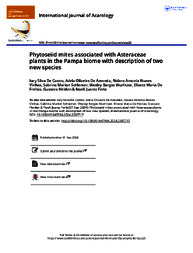Phytoseiid mites associated with Asteraceae plants in the Pampa biome with description of two new species.
Phytoseiid mites associated with Asteraceae plants in the Pampa biome with description of two new species.
Author(s): CASTRO, I. S. de; AZEVEDO, A. O. de; VINHAS, N. A. N.; SCHLEMER, S. M.; WURLITZER, W. B.; FREITAS, E. M. de; HEIDEN, G.
Summary: Abstract: he Brazilian Pampa is predominantly composed of native grasslands with riparian and thickets forest formations, with rich and little known biodiversity of fauna, flora and fungi. The objective of this study was to report phytoseiid species associated with Asteraceae plants from eight physiographic regions of the Pampa biome. Collections were carried out seasonally from November 2021 to August 2022. In each physiographic region, ten species of Asteraceae were collected, totalling 320 samples. Data analysis was mainly based on the relationship between mite and plant. A total of 228 mite specimens of Phytoseiidae were found, represented by 26 species within 12 genera and three subfamilies. Two new species, Amblyseius senecinis n. sp. and Typhlodromus (Anthoseius) bacchariae n. sp. are described and a key to species from the arizonicus group is provided. The most abundant species were Typhlodromalus aripo De Leon, followed by Euseius inouei (Ehara & Moraes), Phytoseius guianensis De Leon, Typhlodromus (Anthoseius) bacchariae n. sp. Neoseiulus californicus (McGregor), N. tunus (De Leon) and Metaseiulus (Metaseiulus) eiko (El-Banhawy).
Publication year: 2024
Types of publication: Journal article
Observation
Some of Embrapa's publications are published as ePub files. To read them, use or download one of the following free software options to your computer or mobile device. Android: Google Play Books; IOS: iBooks; Windows and Linux: Calibre.
Access other publications
Access the Agricultural Research Database (BDPA) to consult Embrapa's full library collection and records.
Visit Embrapa Bookstore to purchase books and other publications sold by Embrapa.

